

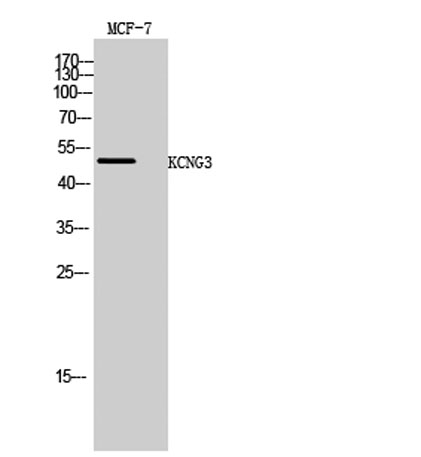
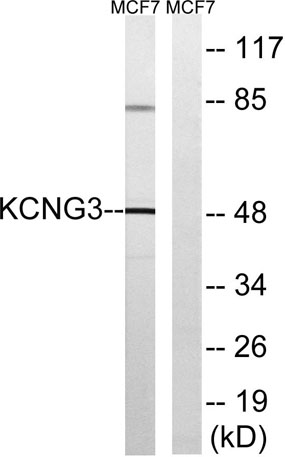
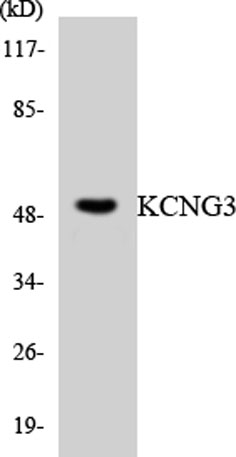
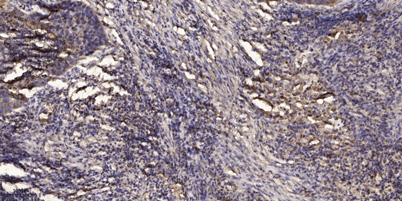
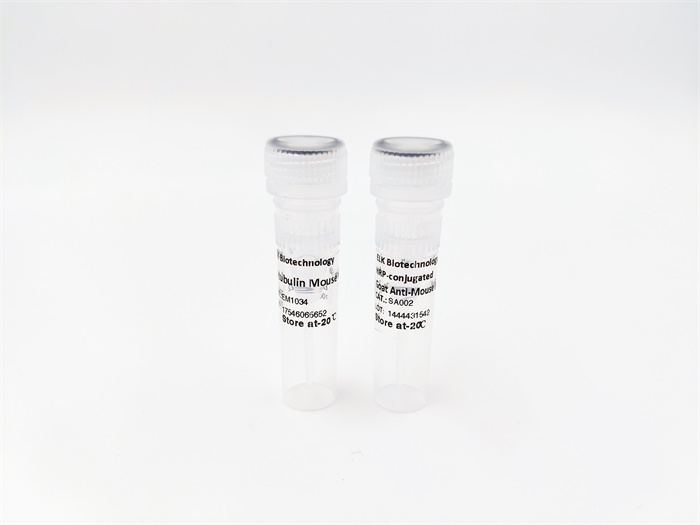



Overview
| Product name: | KCNG3 rabbit pAb |
| Reactivity: | Human;Mouse;Rat |
| Alternative Names: | KCNG3; Potassium voltage-gated channel subfamily G member 3; Voltage-gated potassium channel subunit Kv10.1; Voltage-gated potassium channel subunit Kv6.3 |
| Source: | Rabbit |
| Dilutions: | WB 1:500-2000;IHC-p 1:50-300 |
| Immunogen: | The antiserum was produced against synthesized peptide derived from human KCNG3. AA range:183-232 |
| Storage: | -20°C/1 year |
| Clonality: | Polyclonal |
| Isotype: | IgG |
| Concentration: | 1 mg/ml |
| Observed Band: | 50kD |
| GeneID: | 170850 |
| Human Swiss-Prot No: | Q8TAE7 |
| Cellular localization: | Cell membrane ; Multi-pass membrane protein . Cytoplasm . Has to be associated with KCNB1 or possibly another partner to get inserted in the plasma membrane (PubMed:12060745). Colocalizes with KCNB1 at the plasma membrane (PubMed:12060745, PubMed:19074135). Remains intracellular in the absence of KCNB1 (PubMed:12060745). . |
| Background: | Voltage-gated potassium (Kv) channels represent the most complex class of voltage-gated ion channels from both functional and structural standpoints. Their diverse functions include regulating neurotransmitter release, heart rate, insulin secretion, neuronal excitability, epithelial electrolyte transport, smooth muscle contraction, and cell volume. This gene encodes a member of the potassium channel, voltage-gated, subfamily G. This member is a gamma subunit functioning as a modulatory molecule. Alternative splicing results in two transcript variants encoding distinct isoforms. [provided by RefSeq, Jul 2008], |
-
 Western Blot analysis of MCF-7 cells using KCNG3 Polyclonal Antibody
Western Blot analysis of MCF-7 cells using KCNG3 Polyclonal Antibody -
 Western blot analysis of lysates from MCF-7 cells, using KCNG3 Antibody. The lane on the right is blocked with the synthesized peptide.
Western blot analysis of lysates from MCF-7 cells, using KCNG3 Antibody. The lane on the right is blocked with the synthesized peptide. -
 Western blot analysis of the lysates from HeLa cells using KCNG3 antibody.
Western blot analysis of the lysates from HeLa cells using KCNG3 antibody. -
 Immunohistochemical analysis of paraffin-embedded human Squamous cell carcinoma of lung. 1, Antibody was diluted at 1:200(4° overnight). 2, Tris-EDTA,pH9.0 was used for antigen retrieval. 3,Secondary antibody was diluted at 1:200(room temperature, 45min).
Immunohistochemical analysis of paraffin-embedded human Squamous cell carcinoma of lung. 1, Antibody was diluted at 1:200(4° overnight). 2, Tris-EDTA,pH9.0 was used for antigen retrieval. 3,Secondary antibody was diluted at 1:200(room temperature, 45min).

 Manual
Manual